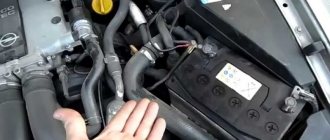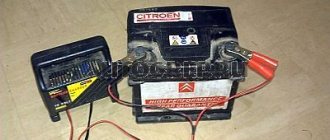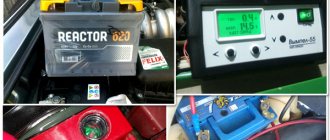In the winter season, the question of how long to charge a car battery becomes especially relevant. A cold start can quickly drain the battery; many motorists solve the problem by replacing the old device with a new one. This solution is not rational and economical. In such a situation, it is wiser to recharge the discharged battery using a special charger.
No specialist can name the exact number of hours required for high-quality charging. It is necessary to focus on the battery capacity, degree of discharge, ambient temperature and other equally important factors.
Preparing the battery for the charging process
One of the main reasons for a decrease in battery capacity is critically low temperature. It is important to take care of the charge level of one of the most important elements in the engine starting system on the eve of the first frost. There is no need to try to invent a device on your own to restore the battery charge level, thereby endangering the safety of yourself and those around you. The right decision would be to purchase special equipment for safe long-term operation. The first step in the charging process is to organize your workspace.
The following requirements are put forward for the room in which the car battery is installed:
- To quickly remove toxic fumes, it must be equipped with ventilation.
- There should be no surges or surges in voltage in the electrical network.
- Availability of necessary fire-fighting equipment.
When a room that meets all the criteria and requirements has been found, you can proceed to the stage of preparing the battery itself. Contacts should be thoroughly cleaned of dirt and oxidation. Then it is recommended to walk over the surface of the device with a soft cloth moistened with ammonia. Also, do not forget about organizing high-quality lighting. At this point, the stage of preparing the battery for recharging can be considered complete.
When should you charge the battery? We list the cases
It is important to start charging the battery at the right time. If you charge it every week, after six months there will be nothing left of the lead plates, and the electrolyte will become cloudy. Periodic charging will not save the battery or extend its life. You need to charge the battery only at the moment when it is really necessary. If you do this too often, you will simply shorten the life of the device and speed up the time for replacement.
Here are some indicators that it’s time to charge the battery:
- indicator on the battery itself - some batteries have special indicators that allow you to determine the charge level in time and renew it if necessary;
- readings from the on-board computer - you should sometimes monitor the voltage in the network before starting the engine using various devices; low voltage indicates that the battery is no longer working well under load;
- changes in the nature of engine starting - if the engine starts starting with a stop during rotation, with a changed sound, too slowly, then it’s time for you to look at the health of the battery;
- more than 3-4 years have passed since the first installation of the battery in the car, at this stage it is necessary to check the performance of the device under load and recharge it to its optimal state;
- When measuring, the device shows low voltage, especially at the moment of load - you can measure these parameters even with a regular tester in order to understand the characteristics of the device’s condition.
Batteries last no longer than 5 years in normal mode. Usually after this period they begin to require constant maintenance. In order not to charge the battery every week, at this stage it is better to purchase a new battery. Usually, specialized stores have a stand for testing batteries under load. This makes it as simple and comfortable as possible to check the battery for the integrity of the plates and the normal state of the electrolyte.
How many hours does it take to charge a serviceable battery?
Motorists also wonder: do the batteries need to be removed from the car? In emergency cases, it is problematic to carry out such a procedure, so there is no need. But to fully and effectively recharge the battery, it is necessary to remove it from the car. It is important to remember that the battery must be completely discharged. To do this, just connect several ordinary light bulbs to the terminals of the device and wait for them to go out. To ensure that the time spent on recharging is not wasted, the density and level of the electrolyte in the models being serviced should be measured. In case of deviations from the norm, restore the electrolyte to normal levels.
How long does it take to charge a 60 Ah battery? For standard 60 Ah batteries, the normal current is considered to be 6A. The value can be calculated using the following formula: the current should be 10% of the total capacity. How long the recharging process will take depends largely on a number of factors. In most cases, 12-14 hours is enough. The condition of the electrolyte should be monitored. If it boils, it means the battery is “filled” to capacity.
Some owners increase the amperage, thereby trying to speed up the process. Indeed, things will go faster, but this method significantly worsens the condition of the lead plates. As a result, the battery will exhaust its resource prematurely. The negative impact of increased current primarily concerns batteries with lead plates. It is also necessary to take care of the voltage level; if it is below the nominal value, there will be no charge. The voltage from the charger should be around 13-14V, which is exactly what the car’s generator produces.
Operating principle of 60 Ah battery
Before you start charging, you need to make sure that the motorist knows how the battery works. Only there will it be possible to use it correctly.
Amp and hours. Battery capacity is measured only in amperes/hour. This means that a 60Ah battery will deliver 60A in one hour. If the load drops to approximately 30 Amperes, then it will supply for 2 hours and so on.
Voltage. Many people mistakenly believe that the voltage should be 12 Volts. But this is not entirely true. The optimal value is 12.6-12.7 Volts . This indicator means 100% charge.
We can conclude that 12 Volts is a battery with a charge level reduced by 40 or 50%.
But with this indicator the car will drive. If the car is fully operational and the generator recharges it, the voltage will soon reach the required value. If the battery shows 11.5-11.6 Volts, then the charger is deeply discharged. At this point, the lead plates will begin to sulfate and the machine will not start.
Auto battery structure
When does a car battery need to be charged?
The installed battery is monitored for open circuit voltage, which should be 12.5 V. The operating voltage is measured at the terminals after the battery is charged on the bench or using a booster. The density of the electrolyte in all banks must be the same, corresponding to the operating conditions of the vehicle. Measurements are taken with the engine running at a shaft speed of 1500-2000 rpm and the high beams on. It is normal if the mains voltage is 13.8 - 14.5 V. Both undercharging and overcharging have consequences for the technical condition of the battery.
For low-maintenance and hybrid batteries, periodic monitoring of the density and electrolyte level is mandatory. Maintenance-free batteries have no caps, are sealed, and can be used as long as they hold a charge. What is important for them is the stability of the network voltage and the absence of discharge to zero.
How to avoid 4 mistakes when preparing to charge
Before you start charging, you must properly prepare the battery. If it is disconnected from the car, immediately carry out a full inspection to avoid troubles during operation.
- The first step is to remove condensation, all dirt and oxide. You need to get rid of all this - wipe the contacts and the entire surface of the battery.
- For this purpose, they usually use an ordinary cloth, which is moistened in a soda solution. We wipe her contacts. As a result, we achieve cleanliness, and this is very important for the proper functioning of the battery. If the battery has a screw-on cap, then when dismantling it, dirt may get into it. This should be avoided, otherwise the battery will fail due to the banks being shorted.
- Unscrew the covers. We check that the electrolyte level is at the required level. If it is not enough, then you will need to add distilled water. The level is checked by the plates. If the solution does not cover them, then topping up is necessary. If you do not replace the electrolyte, the battery will soon stop working. The lead plates will overheat and, as a result, simply crumble.
- Check the density of the electrolyte. For normal functioning it should be 1.26-1.30 grams per cubic centimeter.
This was all the necessary preparatory work. After they are carried out, we proceed to direct charging.
It should be noted that several options can be used. Charging occurs using constant current and the same voltage. Depending on the choice of charging, the time will differ based on the parameters. This is worth thinking about if you don’t have a universal battery charger at home. The universal charger has a minimum of settings, and therefore it is very convenient.
How to properly charge a dead battery
The charger for a car battery is represented by AC rectifiers. These can be devices that allow regulation of the charging current or voltage. How long will it take to charge a completely dead battery?
If the charging station operates at a constant charging current, a battery with a capacity of 60 A/h is fully charged within 20 hours with a constant current of 6 A.
At a constant current value during the charging period, the voltage increases, which leads to abundant gas release from the electrolyte. Therefore, the supplied direct current is reduced stepwise twice, when the voltage reaches 14.4 and 15 V. That is, control of recharging a dead battery needs monitoring and adjustment.
The method of charging batteries at a constant voltage does not require constant monitoring of the process. The target voltage is set, and the current varies from 40 amperes at the beginning to almost zero at the end of recharging. The recharging time for a completely discharged battery will be 24 hours. But maintenance-free batteries will not receive a full charge. 14.5 V corresponds to 90-95% of the battery capacity.
Dependence of battery charge and electrolyte density
Basically, we determine the end of battery charging by the readings of the charger or by the voltage at the battery terminals. But they will not be able to determine the exact state of charge of the battery. To find out how charged the battery is, you need to measure the density of the electrolyte. For this purpose there is such a device as a hydrometer. It is inexpensive and is sold in any car store. We recommend that you definitely have it on your household.
Below you can see a table of the dependence of electrolyte density on the state of charge of the battery:
| Electrolyte density, g/cm. cube (+15 degrees Celsius) | Voltage, V (no load) | Voltage, V (with load 100 A) | Battery charge level, % | Electrolyte freezing temperature, gr. Celsius |
| Electrolyte density, g/cm. cube (+15 degrees Celsius) | Voltage, V (no load) | Voltage, V (with load 100 A) | Battery charge level, % | Electrolyte freezing temperature, gr. Celsius |
| 1,11 | 11,7 | 8,4 | -7 | |
| 1,12 | 11,76 | 8,54 | 6 | -8 |
| 1,13 | 11,82 | 8,68 | 12,56 | -9 |
| 1,14 | 11,88 | 8,84 | 19 | -11 |
| 1,15 | 11,94 | 9 | 25 | -13 |
| 1,16 | 12 | 9,14 | 31 | -14 |
| 1,17 | 12,06 | 9,3 | 37,5 | -16 |
| 1,18 | 12,12 | 9,46 | 44 | -18 |
| 1,19 | 12,18 | 9,6 | 50 | -24 |
| 1,2 | 12,24 | 9,74 | 56 | -27 |
| 1,21 | 12,3 | 9,9 | 62,5 | -32 |
| 1,22 | 12,36 | 10,06 | 69 | -37 |
| 1,23 | 12,42 | 10,2 | 75 | -42 |
| 1,24 | 12,48 | 10,34 | 81 | -46 |
| 1,25 | 12,54 | 10,5 | 87,5 | -50 |
| 1,26 | 12,6 | 10,66 | 94 | -55 |
| 1,27 | 12,66 | 10,8 | 100 | -60 |
Using these values, after measuring the density, you can find out exactly how charged the battery is.
In general, that’s all I wanted to say about how to properly charge a car battery. All that remains is to remind you once again about observing safety precautions. Before charging the battery yourself, it makes sense to ask advice from more experienced car enthusiasts. You should have your own charger and hydrometer. They are not that expensive and they will always come in handy when operating a car.
Information site about energy storage devices
A car battery consists of 6 cells connected in series. Each bank has a full charge of 2.10-2.15 V, so the total voltage is summed up and is 12.6 - 12.8 V. What is the voltage of the battery after the charger is turned off? When installing the battery in a car, the voltage after charging should be 12.4 V. This is normal. The car's starter battery is discharged during engine startup and, while driving, it recovers energy from the car's generator. If the battery voltage drops to 12 V, the device requires charging from the network. A large loss of charge in banks is characterized as a deep discharge that destroys the battery.
The battery is dead, how to charge without charging
If the energy of a dead battery after a long period of inactivity is not enough to set the car in motion, charging from external sources will be required. This could be recharging from the battery of another car or using an external energy source in the form of a battery or booster. You may have to use a pusher. How to apply the first pulse charge, in the future the generator will add energy, but after an emergency drop in charge, it is necessary to take measurements and charge the dead battery with a network station.
A battery that has reached zero is charged with a current of 2-3 A. If the voltage at the terminals does not increase within several hours, the battery needs to be replaced.
Can I “light up” from another car?
Charging a car battery with a charger is not always available. In this case, another battery will be useful, which will be a kind of “donor”. This is quite simple to do: you just need to connect the same terminals of the two devices using wires with alligator clips and turn on the motors. This is what most motorists do. This, of course, is a way out of a difficult situation, but often such “lighting up” ends in the failure of the electrical equipment of the car, because this is a completely wrong approach.
To properly replenish the battery charge in the cold, you must:
1. Turn on the engine and warm it up for 5 minutes.
2. Turn off the engine. Remove the terminal from the negative terminal, connect the cigarette lighter wires to the positive and negative terminals of the battery.
3. After this, you can connect to the donor. Turn on the engine, after a few minutes, without turning it off, disconnect the wires for “lighting up”.
To recharge the battery after this, you should drive in a low gear, the engine speed should be approximately 3000 rpm. In this mode, the generator will provide sufficient current to both charge the battery and operate the vehicle's electrical equipment.
Video
We invite you to watch a video on how to properly charge a car, the devices used, and how to properly prepare the equipment for restoration.
The generator supplies the vehicle with energy while driving. When the engine stops, the battery takes over the “feeding” function.
The service life of this unit lasts on average 2-3 years (equivalent to 80-100 thousand kilometers). The battery stores energy rather than generating it. At the moment when it is at least half discharged, you should think about recharging. Here are some tips.
About what affects the battery charge
Although most batteries are maintenance-free, they still need to be charged. And this largely depends on the operating conditions of the vehicle. If you travel short distances with frequent stops, turning off the engine and starting it again, this negatively affects the actual battery capacity - it decreases.
In addition, a key role is played by the generator, or rather its operating mode. This is especially true for older cars. The bottom line is that the generator produces its optimal characteristics only when it reaches 2,000 rpm. In other words, the idle mode of operation of the power unit is not capable of properly charging the battery, especially if powerful consumers are involved.
In any case, you should know how many amperes are needed to charge the battery. And from time to time (at least before the onset of winter), you need to charge the battery from another power source. And in this case, special devices are used.
Follow safety precautions
Almost everyone understands that you should not unscrew a hot battery with your bare hands. But not everyone knows that the battery contains poisons. The battery contains toxic substances: sulfuric acid, lead, arsenic, hydrogen. It's easy to find information about them.
Below are tips that we strongly recommend following when working with the battery:
- Manipulations with the battery must be carried out in a ventilated non-residential area;
- the ambient temperature where you are working with the battery must be at least +10 °C (if the battery is from the cold, then first it must be allowed to warm up);
- work only in rubber gloves and safety glasses, the skin should be covered with clothing (drivers often do not pay attention to such recommendations, thereby exposing themselves to the risk of, for example, getting a chemical burn);
- you cannot pour water into the acid, you can only do the opposite (otherwise there will be a strong reaction with the release of heat, which can lead to trouble);
- You cannot smoke, light anything, or use devices that produce sparks (the battery produces gases that can ignite);
- this advice is related to the previous one: be sure to let the gases evaporate before charging the battery in order to minimize possible risks;
- After handling batteries, be sure to wash your hands with soap and warm water.
Why is recharging from an external charger necessary?
The battery in the car is charged from an electric generator. But in order to protect electrical equipment, the voltage supplied from this device is limited by a special relay regulator. While to ensure a full charge the voltage must be slightly higher. That is, it is not possible to charge 100% from an electric generator, which forces you to use an external charger from time to time.
External battery charger
In the warm season, this situation is not critical; you can start the car even with a battery charged only a quarter. In winter the situation changes dramatically. Sub-zero temperatures reduce the capacity of the device (in severe frosts it can even be half), but in addition, current consumption will increase due to an increase in the viscosity of the lubricant in the motor. These factors may result in the engine not starting if the charge is not full.
Charging process (step by step instructions)
The process itself is simple: connect the charger wires to the battery terminals, observing the polarity (plus to plus, minus to minus) and insert the plug into the socket.
It is important to understand that there are two methods: direct current charging (do not remove the battery) and constant voltage charging (remove the battery).
Charging with direct current is more efficient, is carried out in several stages, and requires control. This method is more difficult. The process itself is like this:
- we charge the battery with a current that is 10% of the total capacity of the battery (if the capacity is 60A/h, then we charge no more than 6 A), wait until the voltage at the terminals is 14.3-14.4 V;
- to reduce boiling, the next step is to continue charging, reducing the current by 2 times (in this example to 3 A);
- The result is a full charge in approximately 10 hours.
Constant voltage charging is easier, but only provides 80% charge. The voltage is kept between 14-16 V. The current gradually decreases as the battery charges. Here the algorithm looks like this: set the voltage in the range of 14.4-14.5; We wait a day, we get the battery charged to 80%.
Charging time at 60 Ah
Charging time is selected individually depending on the device being used. First you need to understand whether the battery is completely discharged or not.
If we exaggerate and imagine that the battery has completely lost its charge, and there is a current strength of 10% of the nominal value, then it will take 10 hours to fully charge the battery.
If the voltage is adjustable, then we use 4-5 hours for a 90% charge and 8 hours are required for a 100% charge.
All values are at maximum discharge. If the battery is only partially discharged, then the time must be adjusted.
How long to charge the battery
The battery recharging time depends on several factors: the type of device and the amount of current. Less current means more time to recharge.
It takes 15 minutes for the battery to start the engine. Then you need to drive around until the battery is fully charged, while it is recommended to use additional devices that consume current (stove, radio, etc.) to a minimum.
So how long does it take to charge the battery? It takes 10-12 hours to charge the battery.
TOP 2 best 60 Ah batteries
In order for the device to work without problems, it is advisable to buy the best battery models for your car.
- Tudor AGM. The models charge quickly and deliver high current.
- Banner Running Bull. The price is high, but the battery has significant current output.
Any car enthusiast sooner or later faces the problem of charging a battery. There is no way around this and you need to learn how to charge the battery if you don’t already know how. Otherwise, a situation will arise when in front of you there will be a car with a dead battery, and you won’t even know which side to approach it from. On the Internet you can find many questions regarding the charging process. Is it necessary to remove the battery from the car or not? What do you need to charge? How to charge correctly? These are the questions we will try to answer in our material today.
Emergency measures for charging the battery in winter
In the cold season, a situation may arise when the battery “died”. In this case, we recommend removing the battery and moving it to a warm place for half an hour.
You can speed up the process by placing the battery in slightly warm (this is a prerequisite) water. The terminals must remain dry. This is a dangerous method and may shorten the life of the battery. If, for example, the water is too hot, the electrolyte will expand.
Using household appliances such as hair dryers and heaters inappropriately can damage the battery.
State of Charge Estimation
This is an important step that allows you to establish the optimal charging current and determine the time required for the process. The problem is that it is almost impossible to accurately measure the residual charge using available methods. But there are methods that allow you to make an indirect assessment of the condition of the battery, we list them:
- Measuring the voltage on a battery not connected to a load.
- Measuring voltage using a load fork.
- Taking voltage readings from a battery connected to the vehicle network.
- Determination of charge using a hydrometric indicator (provided that it is available in the equipment).
Let's briefly talk about each method.
Measuring the voltage of an unconnected battery
It is necessary to take voltage readings from the battery when it is at rest. To do this, you must wait at least 7 hours after removing the device from the machine or disconnecting it from the charger. To establish the battery charge level, we check the corresponding table.
Table for determining the degree of charge of an unloaded battery by voltage
The data given is suitable for 24, 12 and 6 V acid devices of any type, subject to temperature conditions in the range of 20°C - 25°C.
Measuring voltage using a load fork
In order not to wait six hours, you can take voltage readings using a special device - a load fork. As can be seen from the diagram, this is an ordinary voltmeter, shunted by a resistor.
Appearance and simplified diagram of the device
The resistance value R1 depends on the battery capacity, for example, for 60 A*h it is 0.02 Ohm. Such devices, as a rule, are universal, which allows measurements to be carried out on batteries of various capacities. The device is accompanied by a table that allows you to determine the degree of charge, an example of which is given below.
Table for determining the state of charge using the charging fork
After connecting the device, readings can be taken within 6-8 seconds.
Measuring voltage with the battery not disconnected
In the case where there is no load plug, you can quickly assess the condition of the battery by measuring the voltage on it without disconnecting from the internal network of the machine. To ensure the required load level, you will need to turn on the high beam headlights and turn on the side lights (with the engine off). In this case, the load current will be about 10 Amperes. The charge can be considered sufficient if during the test the voltage does not drop below 11.2 Volts (for 12 V devices).
As an alternative, the method of taking readings while starting the engine is used. In this case, with a normal charge, the device will show 9.5 Volts or more. If the readings are lower, this indicates a critical discharge. Therefore, charging from an external charger is required.
Note that in the latter option, low voltage readings are possible if the starter is faulty.
Concluding the topic of measuring the voltage at the battery contacts, you should pay attention to the accuracy of the measuring device. When determining the charge level, we operate with tenths of a volt, therefore, an error of even one percent will cause an error an order of magnitude higher, that is, about 10%. An error of 5% will increase such an error to 50%, which makes the charge assessment completely meaningless. Based on this, it is advisable to use devices with an error of 0.1%.
Determination of charge using a hydrometric indicator
Some batteries have a special eye, called a hydrometric indicator, with which you can evaluate the charge level.
ISTA battery with hydrometric indicator
Thanks to such devices, it is possible to determine the state of charge without using any measuring instruments for this purpose, which is quite convenient and practical.
Appearance of hydrometric indicators
This device is installed in one of the cans. Structurally, it consists of a transparent tube called a light guide, at the end of which a plastic sleeve with an unsealed V-shaped tube is fixed. Inside the latter there is a float painted green. The float material is selected so that it becomes buoyant at a density of 1.226 g/cm3 and a temperature of 22°C. Under such conditions, it is visible through the peephole, which indicates a charge exceeding 60% (A in Fig. 7).
Figure 7. Design and principle of operation of charge indicators
As the charge decreases, the density of the electrolyte decreases, and the float sinks, rolling into one of the legs. In this case, the peephole will remain dark (B in Fig. 7). This indicates that recharging is required.
In the case when the electrolyte level drops below the permissible level (C in Fig. 7), the observer through the peephole will see reflected light. This means that distillate must be added.
This method of determining charge has two significant drawbacks:
- In cold weather, the density of the electrolyte increases; accordingly, the indicator can display a normal charge level, when in fact it will be less than normal.
- The indicator is installed in one jar, so it only displays its status.
Moving the battery to your home
It happens that a driver rarely drives a car in winter. In this case, experienced drivers strongly recommend removing the battery and storing it in a dry, warm room. The recommendation is supported by the fact that a non-working battery at low temperatures quickly deteriorates in its characteristics. Sometimes this even leads to irreversible damage to the battery.
During such storage, it is important not to forget to charge the battery at least once every 3 months. Then he will always be in “combat” readiness.
In conclusion, we emphasize: be attentive to the car and to yourself. Many unpleasant situations will not happen if you think about your safety in advance. Proper use of the battery will allow you to avoid malfunctions. Careful preparation of the car before a long journey will allow you to get to your intended destination without unnecessary incidents.
Tips and tricks from a specialist
It is allowed to charge without removing the battery. But in this case, you must first disconnect the mass from it.
It is necessary to use only appropriate chargers; chargers from phones and laptops are not suitable for this. True, the latter can theoretically be used if their voltage matches, but to do this, in order to avoid a short circuit, you will need to install a current limiter. Its role can be played by a light bulb from a headlight connected in series with the charger. It is easy to calculate how long it will take to charge, taking into account that such devices have a charging current of no more than 2 A.
It is impossible to charge in the cold; the battery must first be removed from the car and left for several hours in a warm room.
Important clarifications and calculations
How long does it take to charge the battery if you want to get a longer service life from it without causing harm? The fact is that any fast charging with high currents can contribute to a decrease in battery capacity , since we are talking about the use of one or another type of charger. It is with them that the confusion occurs. And not only for novice drivers, but also for those who fundamentally do not want to dive into the study of a simple topic related to such concepts as voltage and current.
As you know, there are six “cans” inside the battery. The output voltage of each of them is about 2 V, for a total of 12 V.
However, this indicator is conditional and not entirely accurate:
- the real U of a well-charged battery should be at least 12.6-12.7 V ;
- if it is 12 V or less , the battery is at least 50% discharged;
- if the voltage is 11.6 V or less - a deep discharge, urgent charging is necessary.
Capacity always remains the most important value and depends on how the battery is regularly charged, maintained, and how the battery is operated. The very concept of capacity can be briefly defined as follows: this is the time during which the battery can operate continuously, provided a certain amount of current is supplied.
For example, the most common capacities for car batteries are 55 Ah and 60 Ah. This is followed by batteries with higher ratings of 75 Ah and higher.
The elementary calculations here are as follows (we start from a capacity of 55 Ah, dividing it by the strength of the supplied current):
- When loaded with a current of 55 A, the battery will work for 1 hour ;
- when the load is less (for example, 27 A), the battery works longer, 2 hours ;
- at a load of 13.75 A, the work will already be 4 hours - and so on.
Of course, a strong current load is not applied to the battery under normal conditions. This is important to know in order to understand the concept of safe current. The safe current figure used when charging the battery should be 10 percent of the battery's rated capacity. Thus, you can calculate the battery charging time in the most basic way.
If calculating percentages is difficult, you can use a calculator:
- for a battery with a capacity of 55 Ah, the percentage of safe current will mean 5.5 A ; Read more about what current to charge the battery →
- how many hours will it take to charge the battery - 55÷5 = 10 hours .
It is very easy to calculate these indicators. They will help you understand that a five-hour express charge for car batteries is clearly not enough. In order for the battery to last longer and not have to be changed frequently, you should understand how to charge the battery in such a way as not to “dead” it ahead of time. It is important not only to achieve a real indicator of a charged battery of 12.6-12.7 V. It is important to ensure that this U lasts as long as possible while maintaining optimal capacity.
Constant voltage charging time
This option is gaining increasing popularity - it is this principle that is implemented on many Chinese devices, where there are practically no “VOLTAGE” and “AMPERAGE” indicators, but only glowing “dots” or a scale that indicates the charge. This device is designed specifically for maintenance-free batteries, because you will not be able to watch the boiling of the electrolyte and the release of gas from it, because everything is sealed. Therefore, the first option is not entirely good. Here the voltage and amperage are automatically adjusted.
SO : The voltage can float in the range from 13.8 to 14.5V, the higher the voltage, the faster the charge.
So in the first hour the battery can absorb from 50 to 60% of the nominal capacity. That is, if it is 60A, then 60X60% = 36A
In the second hour - the voltage drops and the charge occurs more slowly, about 15 - 20%
The third hour is even lower, about 7 – 8%
The fourth is almost full capacity at 90 - 96%.
The subsequent hours are not really needed, the current strength can “drop” to 0.2A, charging to 100% will take almost the same 10 hours.
This option is convenient because you don’t need to worry about setting up the device – it will do everything for you.
DETAILED VIDEO - MUST WATCH!
Battery charge monitoring
By monitoring the battery charging process with a multimeter, you can only get a mediocre idea of what exactly is happening. Of course, it is necessary to know how many amperes to charge the battery, but to obtain more accurate information it is worth measuring the density of the electrolyte. And for this you cannot do without another device, which every driver should have in any case. We are talking about a hydrometer.
The electrolyte density must be measured in each jar, and the degree of charge is assessed based on the resulting average value. Moreover, this characteristic itself should be approximately the same in all containers. However, minor deviations may be present, which is normal.
If the battery is not completely dead yet
How long should a lead-acid battery be charged if, for example, the voltage has not yet dropped to critical levels? It is known that U 12 V means that the battery capacity is already 50 percent or less. But in this case it is not necessary to keep the battery charged for 10-12 hours.
Here are a few more short calculations:
- at a voltage of 12 V, charging time can be reduced to 7 hours, but not less ;
- If U is 11.6 V or less , it is better to charge for 12-15 hours .
During the charging process using a DC device, the voltage changes - up to 13.8-14.4 V. The voltage must be greater than the rated charge of 12 V, otherwise the current from the charger will not flow into the battery. If the battery is completely discharged, in 5-6 hours its charge will be 90-95 percent. In any case, you will have to wait up to 10 hours to reach 100 percent, because the current gradually becomes smaller towards the end of charging.
In conclusion, for novice car enthusiasts, it can also be noted that there is no specific time for charging batteries with different capacities. Everything depends only on the current and voltage indicators, the meaning of which should be understood in order to treat your car’s battery as carefully as possible. With the help of simple calculations and logical conclusions, you can understand that 5-6 hours is not enough time to properly charge the battery. It is better to wait the required amount of time in order to maintain the productive performance of the battery for as long as possible.
In winter, topics related to car batteries are especially relevant, because a cold start can quickly discharge it. Many people change old batteries ( simply handing them over to buyers ), buy new ones (the main thing is to choose the correct polarity ) - however, most try to recharge them and use them further. Fortunately, modern batteries last quite a long time (about 4 - 5 years), but this period can be much reduced! If you apply the current incorrectly and calculate the charging time incorrectly, the battery can quickly fail. Therefore, today we have detailed information about how long it takes to charge your battery...
THE CONTENT OF THE ARTICLE
I would like to immediately make a reservation - we will charge the car battery at home with a special charger, at an approximate temperature of 25 degrees Celsius, this is important, because if the temperature exceeds 35 degrees, then it is better not to start the process (here is the dependence of the temperature of the electrolyte and the surrounding air)! The thing is that the electrolyte has different densities at different temperatures (by the way, you can see how much of it is in different batteries ). However, I suggest remembering the principles of charge and discharge.
Two types of battery charger
There are two types of chargers:
- Direct current.
- Constant voltage .
Constant voltage memory
The so-called express charging of the battery lasting 5 hours is usually carried out with a popular Chinese charger, which uses the principle of constant voltage (14.4 V). When this device is connected to a battery, it provides more than 10 percent of the current rating: 25-30 A in the first hour of charging. The battery will withstand this current and will charge very quickly, but it will also run out much faster. The current drops in the first 3-4 hours, but the voltage remains constant. In five to six hours the battery will be charged to 90-95 percent.
How to set the battery charge level
Determining battery charge
To determine how charged the battery is, take into account its voltage. You can check this characteristic in two ways:
- Carry out the usual measurement of electrical voltage at the battery terminals. To do this, use a digital voltmeter. This device will allow you to show the exact value of the battery voltage level down to tenths and even hundredths of a volt. To measure, the discharge and charging current must be absent for 4-5 hours so that the voltage returns to a normal stable state. There should be a reading between 12.5 and 12.9 volts. Special chargers with a microprocessor and memory are useful. They allow you to more accurately determine the charge level. Such devices are capable of monitoring the discharge and charge of the battery over several cycles.
- The density of the electrolyte is determined, and this parameter is used to determine the degree of charge of the battery. But this option is only suitable for devices with liquid electrolyte.
DC charging time
I think there is no need to explain that you connect the negative terminal of the battery to the negative terminal of the “charger” with the positive terminal in exactly the same way. Many people adhere to this option, because the “Amperage” that we supply to the battery is a very important parameter - it should never be exceeded, and if it is greatly underestimated, the battery will take a long time to charge.
I would also like to warn you that the voltage must be higher than the nominal voltage - that is, from the charger we get about 13.8 - 14V, about the same as a car generator gives. Only then will the charge begin; if the voltage is less than 12 (and even more so 11V), then nothing will happen, but will most likely worsen the discharge.
SO : The optimal voltage is considered to be 10% of the total battery capacity, that is, if you have 75 Ah, then you need to charge with a current of 7.5A.
Thus - if your battery is completely discharged (voltage less than 11.7V), then it should charge in 10 hours! However, the time may be reduced depending on the discharge level.
In the version with a serviceable battery, this is quite easy to determine - as soon as bubbles appear from the surface of the electrolyte in the banks, this means that the charge has been fully completed.
I would like to add on my own behalf - in ancient times (about 20 years ago), my father very often charged the battery at home, especially in winter. He set the 60Ah option to a current of 2A and left it overnight, so the battery took the required amount of energy from this small current. It should be noted that the discharge was not deep then. Therefore, if you just want to “feed” your battery, for example, the voltage at the contacts is exactly 12V, set it to a current of 1 - 2A overnight!
However, now there is another method that also requires a minimum of human intervention.











